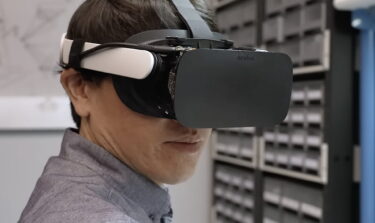How good are Meta's new VR prototypes? First field report

Yesterday Meta presented new VR technology. One journalist visited the research labs and tried out the prototype headsets. Here are his conclusions.
Butterscotch, Starburst and Holocake 2: These are the names of the devices that Meta showed for the first time and that I present in detail in an article about the new headset prototypes. Another, older prototype called Half-Dome was also demonstrated.
The first independent field report about the devices appeared at the same time as yesterday's presentation: Norman Chan from the YouTube channel Tested was allowed to visit the research labs of the Display Systems Research department in Redmond and describes his impressions.
It's one thing to hear about the technical features of a prototype. It's another to learn about their impact. What impression did the devices make on Chan?
Content
Half-Dome
Chan first tried Half-Dome 1: a prototype from 2018 whose special feature is the varifocal display. This allows users to focus on virtual objects as naturally as if they were part of the physical environment, unlike traditional VR headsets. The result is a more pleasant and sharper visual experience, especially at close range.
The VR headset connects to a PC. Chan played Luckey's Tale this way and tried out the Rift experience First Contact.
He describes his impressions as follows: "The demo just kinda worked. I was surprised by how quickly my eyes adapted to the ability to bring objects close to my face and see them clearly and in focus. And I was even more surprised by how quickly I started taking this new level of comfort for granted."
Overall, he said, the image was more comfortable, sharper, and less taxing and tiring on the eyes. You can check out the details in the video below. I have picked out the exact spot for you.
Butterscotch
Butterscotch is Meta's first prototype with "retina resolution". It achieves a pixel density of 55 PPD with a field of view that is half that of the Meta Quest 2. The standalone device achieves a pixel density of 20 PPD.
Butterscotch, like Half-Dome, requires a PC. Chan put on the virtual reality headset and was able to adjust the PPD number via a dial during his demo and see the differences that way. The spectrum ranged from the pixel density of an Oculus Rift up to the 55 PD of the Butterscotch prototype.
"After we passed 35 PPD text rendered about two meters away was easily readable and at the max PPD it was far and away the sharpest image I've seen in headset. A virtual eye chart posted at the far end of the room was completely readable and clear for me," Chan says.
"It wasn't even that the text stood out the most I started to get enamored with textures on objects in that room the vividness of the wall art or the pillows on that virtual couch I couldn't stop looking at them."
Starburst
Starburst was developed to demonstrate the immersive potential of HDR - extremely high luminance and contrast.
The luminance of a display is specified in nits. Meta Quest 2 reaches about 100 nits and a good HDR TV reaches 1,000 nits. Starburst reaches 20,000 nits and can thus accurately simulate indoor or nighttime lighting conditions.
Mark Zuckerberg thinks HDR is more important than variable sharpness or retina resolution, at least when it comes to visual realism. Norman Chan's reaction was, "Wow!"
In the demo, Chan saw a virtual environment with dark and glowing spheres. He was shown various levels of brightness: from 100 to 1,000 to 20,000 nits. The higher the luminosity, the more real the light source appeared.
"I can physically feel my eye adjusting to it as I shift between them," Chan says. "It looked more believable. There was a believability to even though it didn't need to be you know retina resolution, but looking at just luminance. It almost created depth. Things look flat on a traditional laptop or phone."
Holocake 2
Holocake 2 is a prototype with an exceptionally thin and light display: a novel combination of holographic lens and pancake lens. Hence the name.
Visually, Holocake 2 is on par with a Quest 2. The special feature of the prototype is the form factor, which is even narrower than Meta's upcoming VR headset Project Cambria (info), which uses pancake lenses.
Chan also emphasized exactly this aspect: "While the in-headset visuals were comparable to that of a Quest 2 I was really struck by the lightness of the form factor. When I put up my hand up to my face to adjust the headset it was so startling to forget that there was no typical headset bulk sticking out for my eyes. Once pancake lenses become standardized it'll be difficult to go back to the form factor used today," Chan said.
Note: Links to online stores in articles can be so-called affiliate links. If you buy through this link, MIXED receives a commission from the provider. For you the price does not change.